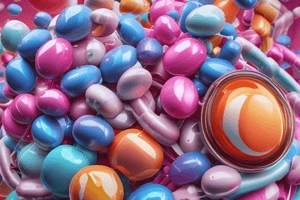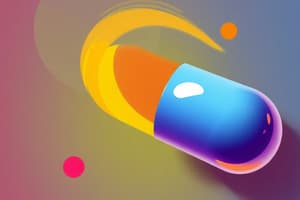Podcast
Questions and Answers
A pharmacist is deciding between a liquid formulation and a standard tablet for a geriatric patient with dysphagia (difficulty swallowing). Which aspect of dosage form design is the pharmacist primarily addressing?
A pharmacist is deciding between a liquid formulation and a standard tablet for a geriatric patient with dysphagia (difficulty swallowing). Which aspect of dosage form design is the pharmacist primarily addressing?
- Ensuring drug stability and quality.
- Optimising therapeutic outcomes. (correct)
- Selecting appropriate multi-source drug products.
- Managing potential drug interactions.
A pharmacist is preparing a topical cream for a patient with a skin condition, but the required concentration of the active ingredient is not commercially available. Which of the following actions represents the application of dosage form design principles?
A pharmacist is preparing a topical cream for a patient with a skin condition, but the required concentration of the active ingredient is not commercially available. Which of the following actions represents the application of dosage form design principles?
- Dispensing a double dose of a commercially available, lower-strength cream.
- Advising the patient to alternate between two different commercially available creams.
- Compounding a cream using the active ingredient and appropriate excipients to achieve the desired concentration. (correct)
- Substituting an oral medication with similar therapeutic effects.
In which scenario is a pharmacist directly applying knowledge of dosage form design to ensure drug stability and quality?
In which scenario is a pharmacist directly applying knowledge of dosage form design to ensure drug stability and quality?
- Recommending a brand-name drug over a generic version to avoid potential allergic reactions.
- Adjusting the dose of a medication based on the patient's weight and kidney function.
- Selecting appropriate packaging and storage conditions to prevent drug degradation. (correct)
- Advising a patient to take their medication with food to improve absorption.
A pharmacist discovers a potential interaction between magnesium stearate (a tableting lubricant) and the active ingredient in a new tablet formulation. What action demonstrates the pharmacist's understanding of dosage form design?
A pharmacist discovers a potential interaction between magnesium stearate (a tableting lubricant) and the active ingredient in a new tablet formulation. What action demonstrates the pharmacist's understanding of dosage form design?
A pharmacist is evaluating different generic versions of a medication to ensure they are therapeutically equivalent. What aspect of dosage form design is most relevant in this evaluation?
A pharmacist is evaluating different generic versions of a medication to ensure they are therapeutically equivalent. What aspect of dosage form design is most relevant in this evaluation?
A long-acting injectable suspension is required. What is the primary consideration of this dosage form, compared to a standard immediate-release injectable solution?
A long-acting injectable suspension is required. What is the primary consideration of this dosage form, compared to a standard immediate-release injectable solution?
A pharmacist is creating a compounded oral solution for a patient with allergies to several common preservatives. Which of the following steps is most crucial to ensure the safety and efficacy of the compounded medication?
A pharmacist is creating a compounded oral solution for a patient with allergies to several common preservatives. Which of the following steps is most crucial to ensure the safety and efficacy of the compounded medication?
Why is the consideration of a drug's chemical properties important when designing a dosage form?
Why is the consideration of a drug's chemical properties important when designing a dosage form?
Which of the following scenarios best describes a situation where a pharmacist would prepare an extemporaneous medicine?
Which of the following scenarios best describes a situation where a pharmacist would prepare an extemporaneous medicine?
What is the primary role of excipients in finished pharmaceutical products?
What is the primary role of excipients in finished pharmaceutical products?
A new pharmacist is asked to compound a medicine. Which resource would provide the most relevant guidelines for this task in Australia?
A new pharmacist is asked to compound a medicine. Which resource would provide the most relevant guidelines for this task in Australia?
What is a key difference in the regulatory oversight between licensed and unlicensed medicines in Australia?
What is a key difference in the regulatory oversight between licensed and unlicensed medicines in Australia?
What is the main role of the Therapeutic Goods Administration (TGA) in Australia's medicine manufacturing process?
What is the main role of the Therapeutic Goods Administration (TGA) in Australia's medicine manufacturing process?
A pharmaceutical company wants to export a new medicine to multiple countries, including Australia, the USA, and countries in Europe. Which organization's guidelines would they likely consult to ensure their product meets international standards?
A pharmaceutical company wants to export a new medicine to multiple countries, including Australia, the USA, and countries in Europe. Which organization's guidelines would they likely consult to ensure their product meets international standards?
What does the term 'dosage form' refer to in the context of pharmaceutical products?
What does the term 'dosage form' refer to in the context of pharmaceutical products?
Which of the following describes the purpose of 'formulation science'?
Which of the following describes the purpose of 'formulation science'?
A pharmacist is preparing an extemporaneous medicine. According to Australian guidelines, what standards should they comply with?
A pharmacist is preparing an extemporaneous medicine. According to Australian guidelines, what standards should they comply with?
If a hospital pharmacist needs to prepare a specific antibiotic solution that isn't commercially available in the required strength, what type of preparation would this be classified as?
If a hospital pharmacist needs to prepare a specific antibiotic solution that isn't commercially available in the required strength, what type of preparation would this be classified as?
Flashcards
Dosage Form Design
Dosage Form Design
Creating medicine that is safe, effective, and convenient for the patient.
Dosage Form
Dosage Form
The active drug combined with inactive ingredients (excipients).
Excipients
Excipients
Inactive ingredients that can enhance the active drug.
Primary Aim of Dosage Form
Primary Aim of Dosage Form
Signup and view all the flashcards
Optimising Therapeutic Outcomes
Optimising Therapeutic Outcomes
Signup and view all the flashcards
Ensuring Drug Stability
Ensuring Drug Stability
Signup and view all the flashcards
Compounding
Compounding
Signup and view all the flashcards
Managing Drug Interactions
Managing Drug Interactions
Signup and view all the flashcards
Formulation Science
Formulation Science
Signup and view all the flashcards
Extemporaneous Preparations
Extemporaneous Preparations
Signup and view all the flashcards
Licensed Medicines
Licensed Medicines
Signup and view all the flashcards
Unlicensed Medicines
Unlicensed Medicines
Signup and view all the flashcards
TGA (Therapeutic Goods Administration)
TGA (Therapeutic Goods Administration)
Signup and view all the flashcards
Good Manufacturing Practice (GMP)
Good Manufacturing Practice (GMP)
Signup and view all the flashcards
CMI (Consumer Medicine Information)
CMI (Consumer Medicine Information)
Signup and view all the flashcards
ICH (International Council for Harmonisation)
ICH (International Council for Harmonisation)
Signup and view all the flashcards
Study Notes
- Dosage form design involves creating safe, effective, and convenient medicines, combining active drug substances with inactive excipients to ensure predictable and reproducible therapeutic responses.
Significance and Basic Definitions
- Dosage form design is crucial for pharmacists to optimize therapeutic outcomes through appropriate selection based on patient factors like age and swallowing ability.
- It helps ensure drug stability and quality by understanding how chemical interactions, packaging, and environmental conditions affect medications.
- Compounding allows pharmacists to create customized dosage forms when commercial options do not meet specific patient needs.
- Comprehensive knowledge of dosage form design enables pharmacists to manage potential drug interactions based on both active and inactive pharmaceutical ingredients.
- Pharmacists use dosage form knowledge to select appropriate multisource drug products, understanding pharmaceutical equivalence, bioequivalence, and therapeutic equivalence.
- Finished pharmaceutical products consist of active pharmaceutical ingredients (APIs) and excipients, with excipients serving various functions such as stabilization and API release modification.
- A dosage form is the physical form in which a drug is delivered, ensuring safety, efficacy, and stability through a combination of APIs and excipients.
- Formulation science aims to establish a precise medicine composition and preparation method.
- Extemporaneous preparations are compounded by a pharmacist.
Manufacturing Medicines in Australia
- Medicines are typically administered as medicinal preparations manufactured by the pharmaceutical industry (TGA licensed) or compounded by pharmacists (exempt from TGA license).
- The manufacturing process must always ensure the safety and quality of the medicine.
- Pharmacists can dispense both licensed and unlicensed medicines.
Regulatory Aspects of Dispensed Medicines in Australia
- Licensed medicines are manufactured by the pharmaceutical industry under strict TGA regulations.
- These regulations include Good Manufacturing Practice (GMP) licenses with regular TGA audits.
- TGA-approved consumer medicine information (CMI) and product information (PI) documentation is available for scheduled medicines.
- Unlicensed medicines are compounded by pharmacists without a GMP license and possibly no TGA-approved CMI or PI.
- Unlicensed medicines require a prescriber's request.
- Unlicensed medicines requires pharmacists trained in compounding medicines.
- Unlicensed medicines must be "extemporaneous" preparations complying with default standards such as the PIC/S guide to good manufacturing practices and pharmacopeias.
- Labelling and consumer information should follow best pharmacy practice standards.
- The Australian Pharmacy Board publishes compounding guidelines, emphasizing dosage forms and formulations.
Authorities and Resources for Regulatory Guidelines on Medicine Manufacturing
- The Therapeutic Goods Administration (TGA) is responsible for medicine market approval, manufacturer licensing (GMP), and auditing in Australia.
- TGA defines the "default standards" for compounding.
- The International Council for Harmonisation of Technical Requirements for Pharmaceuticals for Human Use (ICH) provides technical guidelines on product quality and safety for industrial pharmaceutical production.
- International regulatory agencies, including the TGA, FDA (USA), and EMA (Europe), follow ICH guidelines.
- The Pharmaceutical Inspection Co-operation Scheme (PIC/S) leads in harmonizing GMP standards and quality systems for medicinal product inspectorates.
- PIC/S publishes GMP audit guidelines followed in Australia.
- The Australian Pharmacy Board publishes compounding guidelines with conditions for pharmacists.
Types of Extemporaneous Preparations by Trained Pharmacists in Australia
- Trained pharmacists are legally authorized to compound extemporaneous preparations.
- Extemporaneous refers to specific circumstances requiring timely preparation of a medicine that is not immediately commercially available.
Studying That Suits You
Use AI to generate personalized quizzes and flashcards to suit your learning preferences.
Description
Dosage form design is crucial for pharmacists to optimize therapeutic outcomes. It ensures drug stability and quality. Compounding allows for customized dosage forms when commercial options don't meet needs.




